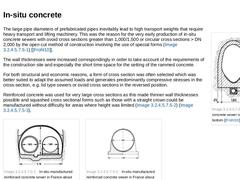
|
(Image: In-situ concrete sewer of 1910 with lined bottom (Frühling, 1910))The large pipe diameters of prefabricated pipes inevitably lead to high transport weights that require heavy transport and lifting machinery. This was the reason for the very early production of in-situ concrete sewers with ovoid cross sections greater than 1,000/1,500 or circular cross sections > DN 2,000 by the open cut method of construction involving the use of special … |
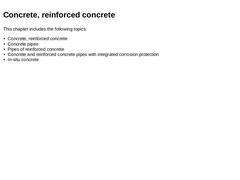
|
|
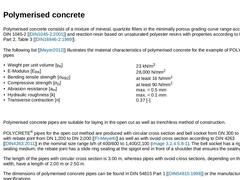
|
Polymerised concrete consists of a mixture of mineral, quartzite fillers in the minimally porous grading curve range according to DIN 1045‑2 [ [DIN1045-2:2001]] and reaction resin based on unsaturated polyester resins with properties according to DIN 16946 Part 2, Table 3 [ [DIN16946-2:1989]]. The following list [ [Meyer2012]] illustrates the material characteristics of polymerised concrete for the example of POLYCRETE® pipes -
Weight per unit volume […
|
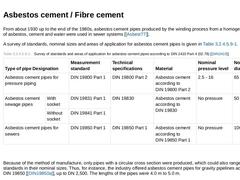
|
From about 1930 up to the end of the 1980s, asbestos cement pipes produced by the winding process from a homogeneous mixture of asbestos, cement and water were used in sewer systems [ [Asbest77]]. A survey of standards, nominal sizes and areas of application for asbestos cement pipes is given in Table 1‑58. (Table: Survey of standards and areas of application for asbestos cement pipes according to DIN 2410 Part 4 (02.78) (DIN2410)) Because of the method … |
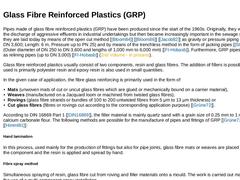
|
Pipes made of glass fibre reinforced plastics (GRP) have been produced since the start of the 1960s. Originally, they were used for the discharge of aggressive effluents in industrial undertakings but then became increasingly important in the sewage sector where they are laid today by means of the open cut method [ [Bloom84]] [ [Bloom86]] [ [Jacob82]] as gravity or pressure piping (DN 100 to DN 3,600; Length: 6 m, Pressure up to PN 25) and by means … |

|
|
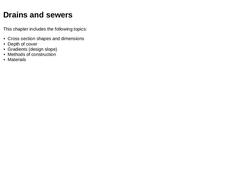
|
|
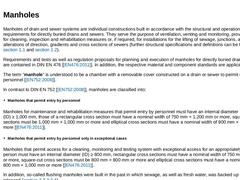
|
Manholes of drain and sewer systems are individual constructions built in accordance with the structural and operational requirements for directly buried drains and sewers. They serve the purpose of ventilation, venting and monitoring, providing access for cleaning, inspection and rehabilitation measures or, if required, for installations for the lifting of sewage, junctions, as well as alterations of direction, gradients and cross sections of sewers (… |
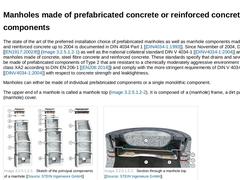
|
The state of the art of the preferred installation choice of prefabricated manholes as well as manhole components made of concrete and reinforced concrete up to 2004 is documented in DIN 4034 Part 1 [ [DIN4034-1:1993]]. Since November of 2004, DIN EN 1917 [ [EN1917:2002/8]] (Image 1‑187) as well as the national collateral standard DIN V 4034-1 [ [DINV4034-1:2004]] are effective for manholes made of concrete, steel fibre concrete and reinforced concrete. … |
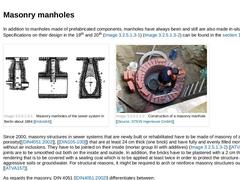
|
In addition to manholes made of prefabricated components, manholes have always been and still are also made in-situ of masonry. Specifications on their design in the 19th and 20th (Image 1‑211) (Image 1‑212) can be found in the (Rubble, cut stone, masonry). (Image: Masonry manholes of the sewer system in Berlin about 1884 [Hobrecht, J., 1884)) (Image: Construction of a masonry manhole (S&P GmbH)) Since 2000, masonry structures in sewer systems that … |
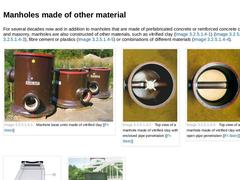
|
For several decades now and in addition to manholes that are made of prefabricated concrete or reinforced concrete components and masonry, manholes are also constructed of other materials, such as vitrified clay (Image 1‑213) (Image 1‑214) (Image 1‑215), fibre cement or plastics (Image 1‑217) or combinations of different materials (Image 1‑216). (Image: Manhole base units made of vitrified clay (Steinzeug GmbH)) (Image: Top view of a manhole made … |
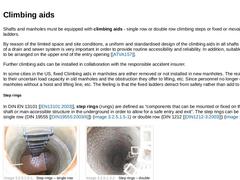
|
Shafts and manholes must be equipped with climbing aids - single row or double row climbing steps or fixed or movable climbing ladders. By reason of the limited space and site conditions, a uniform and standardised design of the climbing aids in all shafts and manholes of a drain and sewer system is very important in order to provide routine accessibility and reliability. In addition, suitable holdfasts are to be arranged on the upper end of the entry … |
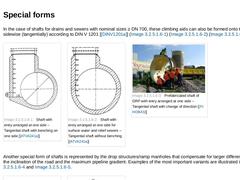
|
In the case of shafts for drains and sewers with nominal sizes ≥ DN 700, these climbing aids can also be formed onto the pipes sidewise (tangentially) according to DIN V 1201 [ [DINV1201a]] (Image 1‑222) (Image 1‑223) (Image 1‑224). (Image: Shaft with entry arranged at one side – Tangential shaft with benching on one side (ATV-A 241)) (Image: Shaft with entry arranged at one side for surface water and relief sewers – Tangential shaft without benching (… |
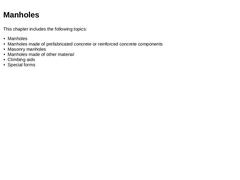
|
|
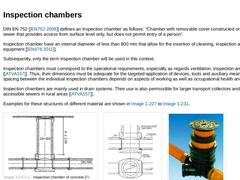
|
DIN EN 752 [ [EN752:2008]] defines an inspection chamber as follows: “Chamber with removable cover constructed on a drain or sewer that provides access from surface level only, but does not permit entry of a person”. Inspection chamber have an internal diameter of less than 800 mm that allow for the insertion of cleaning, inspection and testing equipment [ [EN476:2011]]. Subsequently, only the term inspection chamber will be used in this context. Inspection … |

|
|
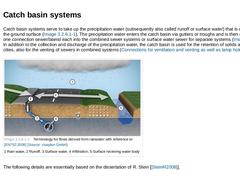
|
Catch basin systems serve to take up the precipitation water (subsequently also called runoff or surface water) that is collected at the ground surface (Image 1-12). The precipitation water enters the catch basin via gutters or troughs and is then discharged via one connection sewer/lateral each into the combined sewer systems or surface water sewer for separate systems (Image 1‑232). In addition to the collection and discharge of the precipitation … |

|
Since the beginning of sewer system construction in the 19th century catch basins were also designated as “street inlets, , gullies” and their constructional design changed over time as a result of changing requirements. Historically, two differently designs of catch basins were in use: -
Catch basin with an invert outlet,
-
Catch basin with a sump.
All other forms that are used in practice today can be traced back to these two designs. |
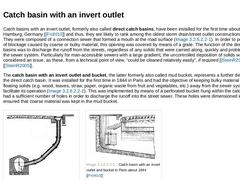
|
Catch basins with an invert outlet, formerly also called direct catch basins, have been installed for the first time about 1840 in Hamburg, Germany [ [Frühl10]] and thus, they are likely to rank among the oldest storm drain/street outlet constructions in Germany. They were composed of a connection sewer that formed a mouth at the road surface (Image 1‑233). In order to prevent the risk of blockage caused by coarse or bulky material, this opening … |

|
|
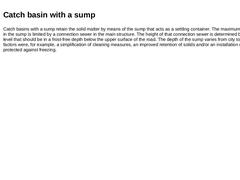
|
Catch basins with a sump retain the solid matter by means of the sump that acts as a settling container. The maximum water height in the sump is limited by a connection sewer in the main structure. The height of that connection sewer is determined by the water level that should be in a frost-free depth below the upper surface of the road. The depth of the sump varies from city to city. Decisive factors were, for example, a simplification of cleaning … |
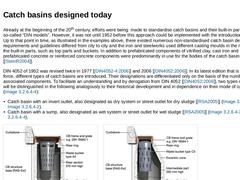
|
Already at the beginning of the 20th century, efforts were being made to standardise catch basins and their built-in parts by means of so-called “DIN models”. However, it was not until 1952 before this approach could be implemented with the introduction of DIN 4052. Up to that point in time, as illustrated in the examples above, there existed numerous non-standardised catch basin designs, as the requirements and guidelines differed from city to city … |

|
For about 30 years now, people have been continually engaged in further developments of catch basins with the objective of improving both the cleaning of these systems [ [Grott1991]] [ [Giesl1997]] [ [[Butle1998]]] and particularly the retention of solids [ [SteinR2004]] [ [SteinR2005]] by means of technical and constructional changes. In recent years, the objectives were amended by the requirement to also use catch basins as local systems for the … |
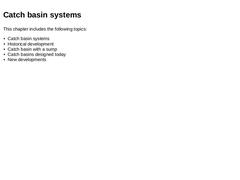
|
|
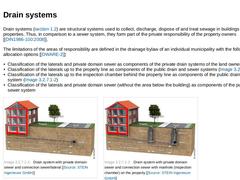
|
Drain systems ( (Terminology / Gravity system)) are structural systems used to collect, discharge, dispose of and treat sewage in buildings and on properties. Thus, in comparison to a sewer system, they form part of the private responsibility of the property owners [ [DIN1986-100:2008]]. The limitations of the areas of responsibility are defined in the drainage bylaw of an individual municipality with the following possible allocation options [ [DWARE-… |